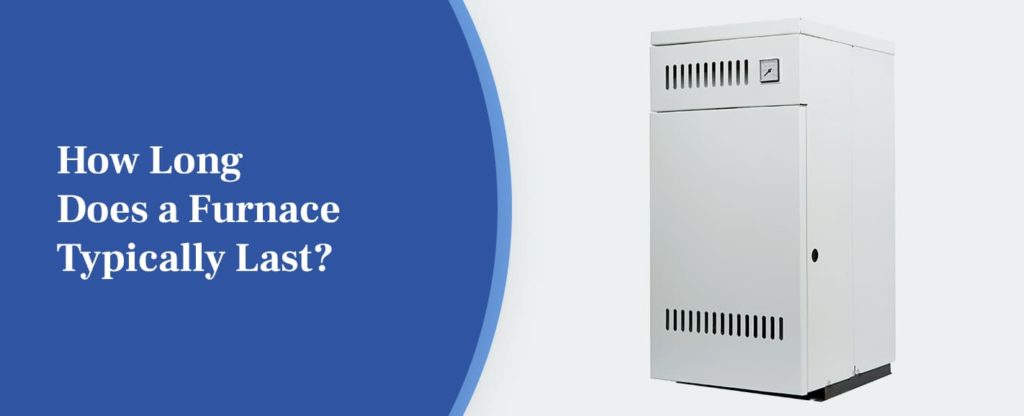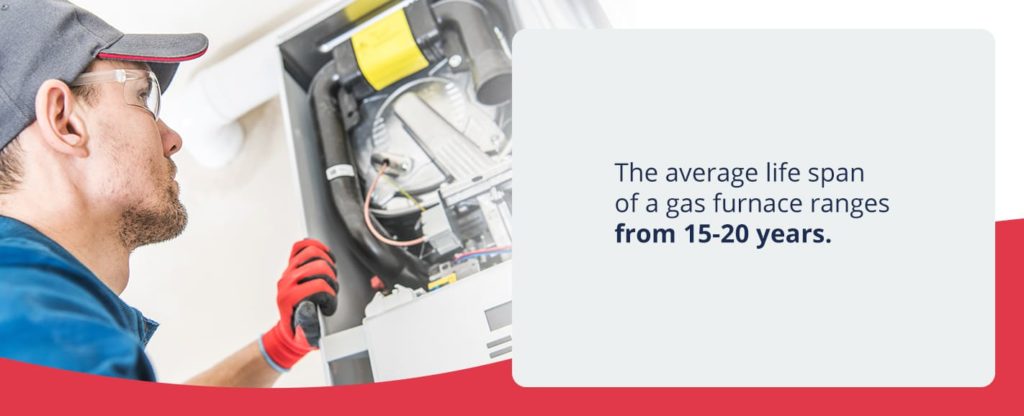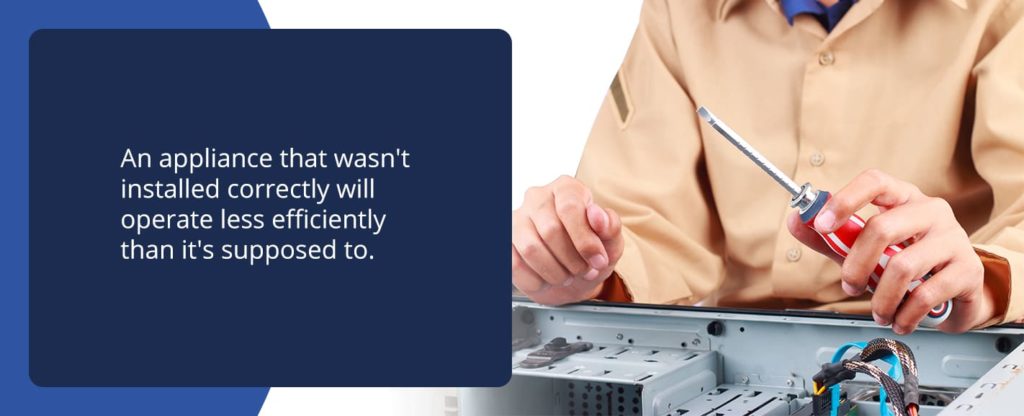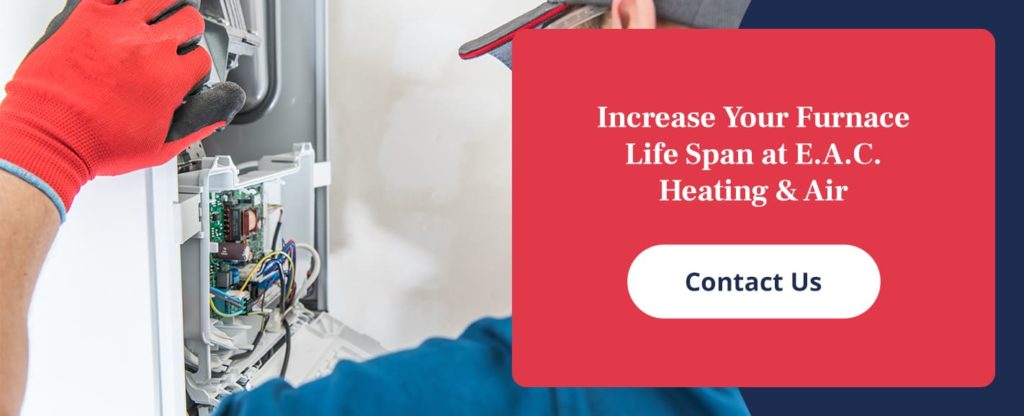
When the cold of the winter months hits, homeowners are quick to fire up their furnaces. Studies show that most American households use natural gas furnaces or electric furnaces as two of their primary heat sources during the winter. However, when homeowners rely on the same furnace year after year, these appliances begin to age, slowly approaching the end of their life cycles.
While this decline is completely natural, an unexpected furnace breakdown in the dead of winter can make for a freezing few days and high costs. That’s why it’s crucial to know the average life span of a furnace, recognize the signs of a needed replacement or repair and implement the proper maintenance to maximize your furnace life expectancy.
How Long Does a Furnace Last?
The average furnace life span is approximately 20-25 years. However, furnace types differ by fuel consumption, giving them different life expectancies.
Knowing how long each type of furnace lasts is essential for preparing you for the end of your furnace’s service life while helping you weigh your options for a new furnace in the future.
How Long Do Oil Furnaces Last?
As their name implies, oil furnaces convert oil into heat. The oil ignites in the combustion chamber while the heat exchanger warms the gas or water. The fan then pulls air from the house and blows it over the heating elements to transform it into hot air. Oil-fired furnaces are particularly popular in geographic areas like the northeast, where access to natural gas is limited.
Though most manufacturers will offer a 10-year warranty on oil furnaces, your unit should last much longer. Oil furnaces can last for up to 25 years, depending on how well you maintain them. If you own an oil furnace, you can expect to get at least 15 years of use out of your appliance at a minimum.
While an oil furnace can function for over 25 years, most aren’t likely to perform as well past this point. If your oil furnace lasts more than 25 years, you’ve been doing the proper maintenance!
Oil furnaces are more likely to reach the upper end of their average life span when you change their filters every two to three months. It’s also important that your oil furnace is sized to match your home’s dimensions. That’s because an oil furnace that’s too small will work harder to heat a large house, increasing the risk of premature furnace failure. If your furnace is too large for your home, it may use more energy than necessary.
How Long Does an Electric Furnace Last?
Electric furnaces use electricity as a heat source for achieving temperatures high enough to melt metal alloys without producing an electrochemical effect. There are two primary types of electric furnaces — arc furnaces and high-frequency induction furnaces.
The life expectancy of an electric furnace is typically 20-30 years, giving it a greater chance of prolonged use compared to other furnace types. This extensive life cycle can be attributed to its simple design. However, electric configurations with thinner linings trade a longer life span for higher power and constant voltage capabilities, giving them a shorter useful service life than those with thicker linings.
How Long Will a Gas Furnace Last?

Gas furnaces ignite natural gas to generate and deliver heat throughout a home. These furnace types are known for their fast heating and economical prices.
The average life span of a gas furnace ranges from 15-20 years, though you may be able to gain additional years of service life with the proper care. However, it’s wise to begin evaluating your furnace replacement options after your gas furnace hits the 15-year mark. Replacing your gas furnace at the lower end of its projected life expectancy reduces the risk of a complete breakdown.
What Does the Age of Your Furnace Mean?
It’s vital to know how old your furnace is to determine how best to handle any operational issues that may come along. If you’re not sure of your appliance’s age, you can typically locate the manufacturer’s serial number inside the furnace cover. If you present this number to a heating professional, they should be able to give you an accurate age.
Even if your furnace is 20 years old, it may still have a few years of life left in it, despite being on the upper end of its life expectancy. Your furnace’s age may indicate the following characteristics.
Regular Maintenace
No matter how old your furnace is, it’s necessary to conduct regular maintenance to keep it operating at peak condition for as long as possible. Whether you perform this routine upkeep yourself or delegate it to a professional maintenance team, a well-maintained furnace will function more efficiently for longer, preventing the risk of unexpected failure.
If your furnace lives through its upper 20s, it’s likely the product of frequent maintenance efforts. Furnaces that break down before their projected life cycle may not have been maintained properly or enough during their service life.
While frequent maintenance is excellent for keeping your furnace in good shape, it also gives you a better idea of when a furnace replacement is required. When you or a professional works on your furnace regularly, you gain a better understanding of how effectively your furnace is functioning instead of basing this determination solely on its age. You’ll get a comprehensive assessment of air filter cleanliness, fan system function and necessary repairs before any issues progress.
Furnace Model
It’s beneficial to know what type of furnace you have so you understand how to replace it when its time comes. For example, if you’ve had a gas furnace that served you well for 15 years, you may want to purchase the same model for your next investment or even buy a similar model with more updated components.
If your original furnace lasted under 15 years or didn’t operate as efficiently as you wished despite delivering the proper maintenance, you may want to look for different furnace models with more dependable features. Investing in a sturdy, high-performing furnace is essential when replacing your old one.
Proper Installation

If your furnace has reached or exceeded its maximum life expectancy, it was likely properly installed when it was new. That’s because a furnace’s quality of installation directly impacts its longevity.
An appliance that wasn’t installed correctly will operate less efficiently than it’s supposed to, causing the system to overwork itself. This overexertion results in greater component wear and tear, higher energy bills and premature burnout. That means that a furnace that breaks down in under 15 years may not have been installed properly when you first purchased it.
Be sure to hire qualified experts when purchasing and installing your residential furnace to protect your investment and increase its life span.
Manufacturing Date
Newer furnaces tend to last longer than older ones. Better technologies have been incorporated into furnaces in recent years, helping them preserve their components, improve performance and ultimately increase system longevity.
Your furnace will likely last longer if it was built within the last 10 years, while it’ll probably reach the end of its service life sooner if it was manufactured over a decade ago.
Do You Need to Repair or Replace Your Furnace?
Furnaces will display various warning signs that indicate if they need to be repaired or replaced. It’s vital to pay attention to these signs so you can take the proper action before it’s too late.
You can gauge your furnace’s replacement time and repair needs by looking for the following symptoms.
Signs You Need to Repair Your Furnace
Just because something seems wrong with your furnace doesn’t mean it’s time to replace it completely. Even the most intimidating symptoms may take nothing more than a simple repair to resolve.
If you notice any of the following indicators, your furnace could likely use repairs:
- Strange sounds: Though furnaces aren’t silent, they shouldn’t make loud noises like banging, squealing or groaning. These sounds may indicate broken or loose components or issues with the fan or belt.
- Wet windows: If your windows are covered in condensation in the morning, the problem may stem from your furnace.
- Difficulty starting: A furnace that won’t turn on or requires multiple tries to start can result from many factors, such as disconnected wiring, broken safety controls, a damaged thermostat or an electrical surge.
- Weak airflow: If you can barely feel the air flowing from your vents, you should schedule a repair to pinpoint the cause.
- Abnormal odor: A strong fuel smell in or around the unit that doesn’t dissipate over time could indicate anything from dust buildup to leaking gas.
- Inadequate heat: Your unit likely needs repairs if it’s producing little to no heat, regardless of your thermostat settings. This may result from a leaking duct.
- Short cycling: Short cycling is when your furnace keeps turning off before your home has reached the desired temperature.
Signs You Need to Replace Your Furnace

As a general rule of thumb, furnaces over 10 years old with repair needs costing over $500 should probably be replaced, as you’d get more value from a new furnace than you would by repairing your existing one. However, certain signs mean it’s time for a replacement no matter how old your unit is.
If your furnace exhibits any of these symptoms, it’s probably time to replace it entirely:
- Increased energy bills: The older a furnace gets, the more energy it’ll use to run properly. This means you may see a spike in your energy bills, which will add up over time, indicating the need for a new, more energy-efficient appliance.
- Frequent repair needs: Though the occasional repair is normal, you shouldn’t have to repair your furnace frequently. If you booked multiple repairs for your unit over the last two years, it’s probably time for a new one.
- Yellow burner flame: If you own a gas furnace and notice that its burner flame is flickering or exhibits a yellow hue, it’s critical to handle the issue and replace your furnace immediately. A yellow flame may indicate the presence of carbon monoxide.
- Carbon monoxide production:Common symptoms of carbon monoxide poisoning include headaches, nausea, confusion, dizziness and flu-like symptoms. If you exhibit these symptoms, your furnace may be leaking carbon monoxide.
- Dry or dusty environment: Old furnaces experience difficulty moisturizing and cleaning the air. If the air in your house feels dry, stale or stuffy or you’re experiencing dust buildup, you may need to replace your furnace.
- Visible damage: Physical damage like cracks and rust may cause your furnace to pollute the air in your home with contaminants.
- Uneven heating: Your furnace should warm every room in your home at the same rate. If certain rooms heat up faster than others, your unit may be no longer able to distribute heat evenly through your home, warranting a replacement.
Tips for Increasing Furnace Life Expectancy
If you’re looking to get the most out of your furnace, you can take various measures to better maintain your unit and ultimately increase your furnace life span. Try implementing the following strategies to protect and optimize your appliance.
Schedule Routine Maintenace
The best way to ensure that your furnace functions properly in the long term is by scheduling heating system maintenance services from experienced professionals. HVAC companies are knowledgeable about the workings of your furnace, meaning they know exactly what to check and adjust to ensure that your furnace is in working order.
Getting a furnace tune-up every fall is an excellent way to catch any functional issues early so your unit is fixed and ready to go when the cold weather hits.
Change Your Air Filters
It’s important to keep an eye on your furnace’s air filters to monitor any dirt or grime buildup. If you notice that your filters are getting dirty, replace them immediately. When your filters are clogged with contaminants, they force your furnace to work harder to pump air through the house, causing components to wear faster and reducing your unit’s service life.
It’s a good rule of thumb to replace your air filters once a month to safeguard your system.
Set Consistent Temperatures
The harder you make your furnace work, the shorter its life expectancy. When you keep your furnace set at one temperature for most of the day, it doesn’t have to work as hard as it would if you constantly adjusted the temperature.
In addition to setting consistent temperatures, you can also preserve your furnace by keeping your home’s temperatures lower when you’re not home to reduce wear and tear.
Insulate Your Home
You can lessen the load for your furnace by ensuring that your home is adequately insulated so no air enters or escapes from the house. You can accomplish this by sealing any air leaks in your home with insulation. Common areas that often exhibit poor insulation include basements, attics, air ducts, windows and doors.
Increase Your Furnace Life Span at E.A.C. Heating & Air
You can get the best life expectancy from your furnace with heating maintenance, repairs or installations from E.A.C. Heating & Air. We are a local, family-owned business dedicated to delivering the most reliable HVAC products and services for residential and commercial clients alike.
Contact us to learn more about our offerings today!

